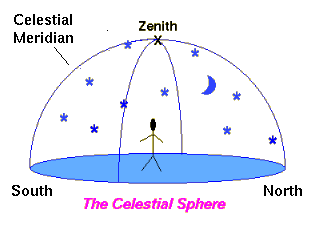
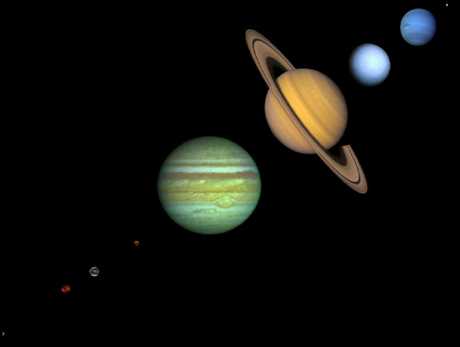 The Sky, Stars, Magnitudes, Celestial Sphere
The Sky, Stars, Magnitudes, Celestial Sphere Much of our initial discussion of Astronomy will concern the motion of objects in the sky. Therefore, we shall introduce some terminology and a coordinate system that allow us to specify succinctly the location of particular objects in the heavens.
CONSTELLATIONS--term originally used to define groups of stars in the sky often named after mythical creatures by the ancients.
Many of the constellations in books of today were named in Mesopotamia over 5000 years ago.
Constellation we know as Orion was known as Al Jabbar (the giant). (...yes, think NBA's lifetime scoring leader).
Originally these were loose groups of stars and not always precisely defined. (Member stars could be part of different constellations)
There are now 88 official IAU constellations, but they now represent regions of the sky
ASTERISMS--smaller groupings within constellations (e.g. Big Dipper, in Ursa Major (the great bear))
2-D projection of 3-D distribution: often the stars have nothing to do with each other gravitationally, they just appear close together when projected on the sky.
Constellation names are mostly Greek, but star names are mostly Arabic. Naming stars is not useful, as there are too many. System is to name the constellation and the order by brightness with Greek letter : e.g. Alpha Scorpii, which represents the brightest star in Scorpii. Beta Scorpii the second brightest etc. But to do real science we need a quantitative system of measurement. One commonly used scale is called the magnitude scale.
Brightest stars as we see them get a higher magnitude rank (like a tennis ranking). The brightest stars get the lowest numbers.
Magnitude scale has negative numbers for the very brightest stars. The sun is -26, since it is so bright as compared to Sirius which is -1.46. Faintest stars that we can see with powerful telescopes are about 28th magnitude.
These are the apparent visual magnitudes in that they describe what we see. They depend on the location of the star as well as the star type. A more distant star of the same type as the sun will be fainter.
Quantitatively we define the intensity as the light energy from a star to hit one square meter in 1 second (per solid angle).
The magnitude system is such that if 2 stars differ by 1 magnitude, their intensity ratio is 2.5.
If they differ by 2 magnitudes, their intensity ratio is 2.5 x 2.5. Etc.
The simple formula is then
I1/I2= 2.5^(m2-m1)
We can then convert the intensity ratio to the magnitude difference (using a calculator).
The one advantage of this system is that it compresses a large range of intensities in small range of magnitudes. For example: 25 magnitudes is a factor of 10^9 in intensity.
Note further that the the inverse of this relation is straightforward to derive. Take the base 10 logarithm, of both sides and we have
Log (I1 / I2) = (m2-m1) Log (2.5)
using the property that Log x^n = n Log x. Noting that Log (2.5) = 0.4, we have
2.5 Log (I1 / I2) = (m2-m1).
This allows us to get the magnitude, given the brightness
ratio.

The point on the celestial sphere that is directly
over our heads at a given time is termed the zenith. The imaginary
circle passing through the North and South points on our
horizon and through
the zenith is termed the celestial meridian. We will introduce
additional terminology associated with the celestial sphere later.
Motion in the Sky
It is clear after only minimal observation that objects change their position
in the sky over a period of time. This motion is conveniently separated into
two parts:
Note that the points on the celestial directly north and south do not move much with the diurnal motion because they are are along the spin axis of the Earth. In fact that is how north and south on the earth are defined--the anti-polar directions along the spin axis. The two anti-podal points which don't move are called the north celestial pole and south celestial pole respectively. The north direction points toward Polaris = north star Pawnee Indian name for Polaris is "star that does not walk around."
Note that the directions we use every day have astronomical definitions.
Actually, all objects are slowly changing their relative positions on the
celestial sphere, but for most the motion is so slow that it cannot be detected
over time spans comparable to a human lifetime; only the "wanderers" have
sufficiently fast motion for this change to be easily visible.
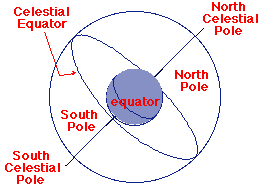 We can define a useful coordinate system for locating objects on the celestial
sphere by projecting onto the sky the latitude-longitude
coordinate system that we use on the surface of the earth. As illustrated in
the adjacent figure, this allows us to define
"North and South Celestial Poles" (the
imaginary points about which the diurnal motion appears to take place) and a
"Celestial Equator".
We can define a useful coordinate system for locating objects on the celestial
sphere by projecting onto the sky the latitude-longitude
coordinate system that we use on the surface of the earth. As illustrated in
the adjacent figure, this allows us to define
"North and South Celestial Poles" (the
imaginary points about which the diurnal motion appears to take place) and a
"Celestial Equator".
The figure illustrates that these imaginary objects
are the exact analogs
of the corresponding imaginary objects on the surface of the earth. Thus, we
shall be able to specify the precise location of things on the celestial
sphere by giving the celestial analog of their latitudes and longitudes, or
something related to those quantities.
Similarly, the distance between objects on the sky can be measured as a projected angular distance with vertex of the angle at our location.
If you view a quarter, from the length of a football field it s1 arc minute (= 1') in diameter, that is, it "subtends" 1 arc minute at this distance or has an angular diameter of 1 arc minute.
A pencil dot subtends about 1 arc second (1") at the same distance.
The angular diameter of the moon is 0.5 degrees.
The angular distance between two objects is defined as the the angular separation of two objects on the sky.
NOTE THAT ANGULAR DISTANCE IS PROJECTED DISTANCE ON THE SKY, NOT AN ACTUAL DISTANCE BETWEEN THE OBJECTS. EXAMPLE: THE ANGULAR DISTANCE BETWEEN TWO POINTS ON THE MOON COULD BE THE SAME AS THE ANGULAR DISTANCE BETWEEN TWO GALAXIES ON THE SKY.
Our latitude is the angular distance between the north celestial pole, and the northern direction of the horizon.
If we were in Australia right now the south celestial pole would be above our horizon, while the north celestial pole would be below.
If we can see the North star from our location we can always measure our latitude since, to a good approximation the north star is at the north celestial pole. This does not help us in the Southern hemisphere!
Latitude also determine which constellations we see. north circumpolar constellations never set in the northern hemisphere. The south circumpolar constellations never set in the southern hemisphere.
Comment: lots of terminology but necessary to fix the language in which we will discuss the motion of bodies. Note differences between 1) terminology, 2) observational classification of what is seen, and 3) conceptual understanding.
We distinguish between
rotation (or spin) of a body and orbit (or revolution).
Rotation is the turning of a body around its own axis. Orbit
is the motion of the body around a point located outside the body.
The rotation of the earth gives us our days, and the orbit around
the sun gives us our yearly seasons.
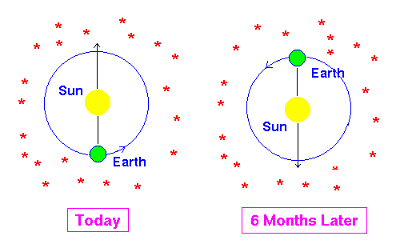 Another important imaginary plane on the celestial sphere is the plane of the
"ecliptic" or
"Path of the Sun", which is the imaginary path that the Sun follows on the
celestial sphere over the course of a year.
As the diagram at left indicates,
the apparent position of the sun with respect to the background
stars (as viewed from Earth)
changes continuously as the Earth moves around its orbit, and will return to
its starting point when the Earth has made one revolution in its orbit.
Another important imaginary plane on the celestial sphere is the plane of the
"ecliptic" or
"Path of the Sun", which is the imaginary path that the Sun follows on the
celestial sphere over the course of a year.
As the diagram at left indicates,
the apparent position of the sun with respect to the background
stars (as viewed from Earth)
changes continuously as the Earth moves around its orbit, and will return to
its starting point when the Earth has made one revolution in its orbit.
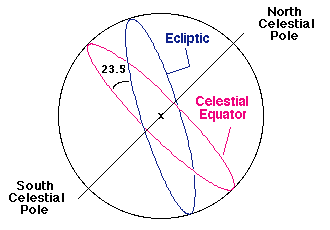 Thus,
the Sun traces out a closed path on the celestial sphere once each year. This
apparent path of the Sun on the celestial sphere is called the
ecliptic. Because the rotation axis of the
Earth is tilted by 23.5 degrees with respect to
the plane of its orbital motion (which is also called the ecliptic), the
path of the Sun on the celestial sphere is a circle tilted by 23.5 degrees with
respect to the celestial equator (see diagram at right).
Thus,
the Sun traces out a closed path on the celestial sphere once each year. This
apparent path of the Sun on the celestial sphere is called the
ecliptic. Because the rotation axis of the
Earth is tilted by 23.5 degrees with respect to
the plane of its orbital motion (which is also called the ecliptic), the
path of the Sun on the celestial sphere is a circle tilted by 23.5 degrees with
respect to the celestial equator (see diagram at right).
The ecliptic is
important observationally, because the planets, the Sun (by definition), and the
Moon are always found near the ecliptic. As we shall see later, this is
because all of these objects have orbits that lie nearly in the same
spatial plane.
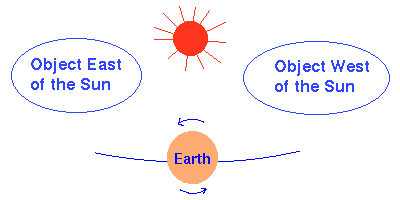
Thus, objects to the west of the Sun on the celestial sphere precede the Sun in the diurnal motion of the celestial sphere (they "rise" before the Sun and "set" before the Sun). Likewise, objects to the east of the Sun trail the Sun in the diurnal motion (they "rise" after the Sun and "set" after the Sun). Generally, one object is west of another object if it "rises" before the other object over the eastern horizon as the sky appears to turn, and east of the object if it "rises" after the other object.
All planets move in nearly circular orbits around the sun. Farther planets orbit more slowly, and all move in same direction around the sun.
The planets always appear near the ecliptic because they orbit the sun in nearly the same plane as the earth orbits the sun, so their apparent path around the Earth is almost in the same plane.
Venus and Mercury are closer to sun than earth so do not wander far from sun in their orbits as seen on the sky. Mercury remains less than 28degrees from the sun at all times.
Venus can appear as bright as -4 magnitudes. It is quite bright around sunset for about 1/2 the year in the western sky.
Zodiac is formally defined as a band of 18 degrees centered on the ecliptic which marks the wedge around the ecliptic that the planets follow. The band is divided into 12 segments, named for constellations along the ecliptic.
A horoscope is technically a map of the position of the sun, planets and moon among the constellations of the Zodiac at a particular time.
this has no possible relation to any human character or behavior or anything. Astrology has no basis in scientific fact. It is merely a superstition that modern science left in the dust centuries ago.